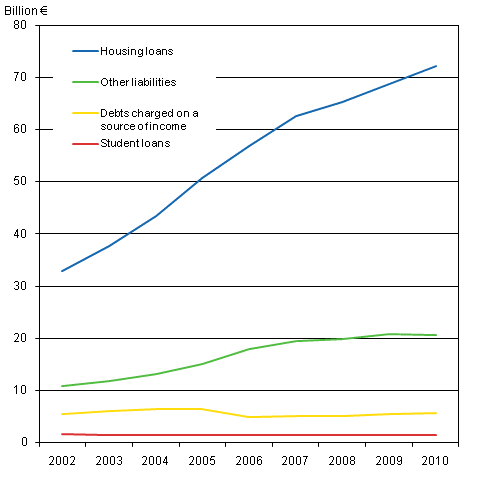Published: 1 July 2011
Housing loans grew in 2010
Last year, household-dwelling units’ outstanding debts amounted to EUR 100 billion, of which EUR 72 billion were housing loans. Housing loans have grown by most, or by 120 per cent. Last year, too, housing loans grew by most and, among them, especially loans taken out for first homes. Housing loans grew by altogether 6.3 per cent and loans for first homes by 11.5 per cent. Household dwelling units' debts have doubled in real terms since 2002. From 2002 to 2010, the share of housing loans of all outstanding debts has gone up from 65 to 72 per cent.
Household-dwelling units ‘debts by type of debt 2002-2010, at 2010 prices

Household-dwelling units' other debts, such as loans for cars, free-time residences or general consumption, amounted to EUR 20.6 billion, accounting for one-fifth of all debts. They grew by0.5 per cent from the previous year. Loans taken out for business purposes grew by 4.6 per cent and study loans by 2.7 per cent. Household-dwelling units' business debts totalled EUR 5.7 billion and their study loans EUR 1.5 billion.
Nearly 60 per cent of household-dwelling units had debts and one in three of them had a housing loan. Indebtedness was most frequent among the household-dwelling units where the reference person was aged between 25 and 44, of which four in five had debts. Approximately one-half of the household-dwelling units in the 25-34 age group and 60 per cent of those in 35-44 age group had housing debt. Households-dwelling units in the 35 to 44 age group had the largest debts: EUR 98,970 per indebted household-dwelling unit. However, slightly younger household-dwelling units in the 35 to 44 age group had the largest housing loans, amounting to EUR 114,550 per household-dwelling unit with housing debt..
Household-dwelling units in Itä-Uusimaa and Åland had the largest debt per indebted household-dwelling unit, amounting to nearly EUR 86,000. However, household-dwelling units in Uusimaa had the largest housing debts of EUR 109,580 per household-dwelling unit with housing debt. Debts grew by most from the previous year in North Karelia and Uusimaa.
During a decade, household-dwelling units' debts have gone up by clearly more than their income. Between 2002 and 2009, their debts grew by 88 per cent in real terms and their disposable income by 22 per cent. The rate of indebtedness of household-dwelling units, that is, the share of their debts of their disposable income, was 70 per cent in 2002 and 109 per cent in 2009. Household-dwelling units with debts equalling at least their annual income numbered 483,200 in 2002 and 693,200 in 2009.
Household-dwelling units where the reference person was aged 25 to 34 were the most indebted. In 2009, their rate of indebtedness was 193 per cent. With the exception of the household-dwelling units of under 25-year-olds, the rate of indebtedness went up from the previous year in all age groups.
Household-dwelling units' interest expenses totalled EUR 2.3 billion in 2010. They decreased by 30 per cent from the previous year. Interests on housing loans fell by 33 per cent in 2010.
Source: Indebtedness 2010. Statistics Finland
Inquiries: Timo Matala (09) 1734 3422, toimeentulo@stat.fi
Director in charge: Riitta Harala
- Tables
-
Tables in databases
Pick the data you need into tables, view the data as graphs, or download the data for your use.
Updated 1.7.2011
Official Statistics of Finland (OSF):
Indebtedness [e-publication].
ISSN=2489-3285. 2010. Helsinki: Statistics Finland [referred: 21.12.2025].
Access method: http://stat.fi/til/velk/2010/velk_2010_2011-07-01_tie_001_en.html

